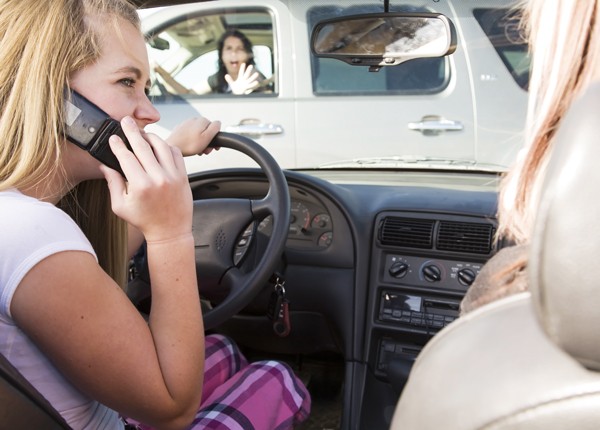
Distracted Driving Prevention Techniques: Interacting with Other Road Users
Updated Dec. 15, 2020If any driver on the road does not have a clear view or cannot anticipate other driver’s actions, the roadway environment becomes more dangerous for all road users. To create a safe environment in which all traffic can share the road in harmony, you must behave in such a way that allows other drivers to prepare for any lane changes, turns and stops you intend to make.
Without effective communication between motorists, it would be impossible to predict the movement of other vehicles and negotiate the roadway safely. Imagine if the drivers around you failed to communicate. You would have to deal with turning vehicles cutting across your path of travel and new vehicles entering your lane without warning. Maintaining a safe speed and following distance would be impossible, as you would not know when or where the traffic ahead of you may stop.
Attentive, conscientious motorists think about how their actions will affect other drivers and endeavor to behave considerately, at all times. It is not simply a matter of being polite, it is a matter of safety.
The basic rules of communication
All drivers must communicate their intention to alter course or change speed, before acting on those intentions. There may also be occasions where you must communicate the presence of a hazard on the roadway or draw attention to the position of your vehicle. Here are the basic rules:
- Activate your left or right turn signal when you intend to enter or exit a highway, turn, change lanes or merge into a new lane of traffic.
- Activate your brake lights by tapping your brake pedal when you intend to slow down or stop.
- Activate your hazard lights to warn other drivers about a nearby hazard.
- Activate your headlights in darkness or low-visibility conditions to warn drivers about the location of your vehicle.
For a more detailed explanation of signaling rules and techniques, check out the “Signaling” module in our Driving Maneuvers section.
Using hand signals
In the event that your signal lights are broken or malfunctioning, you must communicate your intentions to other road users with hand signals instead. Through the driver’s window, you can signal your intention to turn left, turn right or slow down, by extending your left arm straight out, bent and pointing upwards or bent and pointing downwards respectively.
You must learn appropriate hand signals even if you never need to use them yourself, as you may encounter other motorists or cyclists using them. Keep in mind that on very bright days when your signal lights cannot easily be seen, it may be useful to supplement use of your lights with hand signals to ensure other road users can anticipate your intentions.
Timing your signals
Timing your signals appropriately is essential for effective communication. You must activate your signals early enough that other motorists have time to register and prepare for your maneuver, though not so early that they mistake your intentions.
The law in most states specifies that drivers must begin signaling at least 100 feet prior to a turn, lane change or stop. You should check your driving manual for local details, as the minimum signaling distance in your state could be up to 200 feet prior to a turn.
Having completed your intended maneuver, deactivate your signal lights immediately. Other drivers may become confused about your intentions if your signals are on at an inappropriate time.
Using your horn
Your vehicle’s horn should only be used to warn other road users about the immediate danger. Do not use the horn to greet other drivers or express frustration, as this could startle nearby road users and create a dangerous situation where there was not one previously.
Here are some examples of when it would be appropriate to sound your horn:
- 1

A driver ahead of you is holding up traffic at a signal light, as they have failed to notice the light has turned green.
- 2

You are partway across an intersection and notice another driver entering on a path that will intersect with your own, or somebody else’s.
- 3

A driver is mistakenly driving down a street in the wrong direction.
- 4

You have lost control of your vehicle and cannot safely stop.
- 5

Most situations call for nothing more than a light tap on the horn to draw attention to yourself, or a dangerous situation. Try to avoid sounding your horn aggressively as this may frighten or anger other drivers and make an already risky situation worse.
Communication through lane positioning
Other motorists can ascertain a great deal about your intentions simply by observing your driving behavior and your position on the roadway. For this reason, it is important to adopt an appropriate lane position based on your imminent intentions. Otherwise, you may mislead other drivers into thinking you are turning when in fact, you intend to drive straight on – or vice versa.
Here is what your lane position tells other drivers about your intentions:
- Lane position 1 indicates that you are holding your course and position.
- Lane position 2 indicates that you are preparing for a left turn, or that there is a hazard on the roadway ahead.
- Lane position 3 indicates that you are preparing for a right turn, or that there is a hazard on the roadway ahead.
- Lane positions 4 and 5 indicate that you are changing lanes or that there is a hazard in the roadway ahead.
Lane positions 2, 3, 4 and 5 could indicate that you are planning a maneuver OR that there is a hazard in the road. Appropriate use of your signal lights or hand signals will make sure other drivers know the difference. For example, if you assume lane position 2 and activate your left turn signal, other motorists will know that you are preparing to turn. Without the left turn signal, they will anticipate a hazard on the road ahead.
Sometimes, effective communication can be as simple as making sure you are in the correct lane. For example, motorists waiting at an intersection will expect every vehicle in a center left turn lane to execute a left turn. If any driver within the center left turn lane drives straight on, they will surprise other motorists and may cause a collision.
The importance of eye contact
Eye contact and hand gestures are extremely effective communication tools in close quarters. Establishing eye contact with other road users at an intersection can ensure they have acknowledged your presence and are intending to yield. Equally, you can use eye contact and gestures to show another motorist or pedestrian that you have seen them and are allowing them to proceed. Using eye contact is important, as collisions can easily result if you misread another person’s intentions or they misread yours.
Be prepared for mistakes
Whether through distraction, ignorance or irresponsible behavior, most drivers make communication errors at one time or another. You must never assume that another driver has understood your intentions, or that they have effectively communicated their own. Be prepared for mistakes and you should be able to avoid getting caught off-guard.
For instance:
- A driver may mistakenly activate their turn signal or fail to deactivate it after a turn. Do not assume that another motorist will turn, just because their turn signal is on.
- A driver may neglect to communicate their intentions by activating their signal lights or may not realize that their signal light is malfunctioning. Do not assume that a vehicle displaying no signal lights will hold its course.
We cannot accurately predict other motorists’ behavior all the time. All we can do is form a “best guess” about the action they are most likely to take, based on their position on the roadway, signal lights, eye contact and gestures. It is essential to always leave yourself enough space to react and avoid a collision, just in case your best guess turns out to be wrong.




